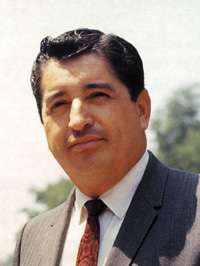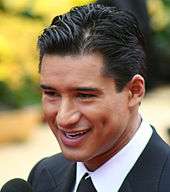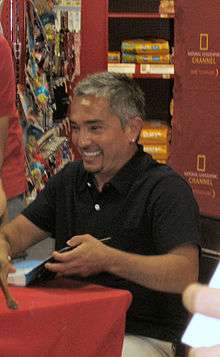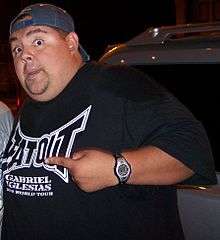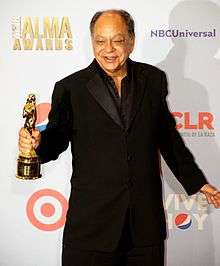Mexican Americans
|
| |
.jpg) | |
| Total population | |
|---|---|
|
35,797,080 11.14% of total U.S. population, 2015[1] | |
| Regions with significant populations | |
| Southwest, West Coast, and Chicago area; there are also emerging populations in the South, Upper Midwest and Northeast. | |
| Languages | |
| Spanish, English, Plautdietsch, and a minority of Indigenous Mexican languages. | |
| Religion | |
| Predominantly Roman Catholic; also Protestant, Anabaptist, indigenous beliefs | |
| Related ethnic groups | |
| Other Mexican diaspora |
Mexican Americans (Spanish: mexico-americanos or estadounidenses de origen mexicano) are Americans of full or partial Mexican descent. As of July 2015, Mexican Americans made up 11.1% of the United States' population, as 35.8 million U.S. residents identified as being of full or partial Mexican ancestry.[1] As of July 2015, Mexican Americans comprised 63.4% of all Hispanics and Latinos in the United States.[1]
The United States is home to the second-largest Mexican community in the world, second only to Mexico itself, and comprising more than 24% of the entire Mexican-origin population of the world. Canada is a distant third with a small Mexican Canadian population of 96,055 (0.3% of the population) as of 2011.[2]
Over 60% of all Mexican Americans reside in the states of California and Texas.[3] In 2012, the United States admitted 145,326 Mexican immigrants,[4] and as of November 2015, over 1.34 million Mexicans were on the waiting list to immigrate to the United States through legal means.[5]
History of Mexican Americans
Communities of Spanish-speaking Tejanos, Nuevomexicanos, Californios and Mission Indians have existed in the American southwest since the area was part of New Spain's Provincias Internas. The majority of these historically Hispanophone populations eventually adopted English as their first language as part of their overall Americanization.
Mexican-American history spans more than 400 years and varies from region to region within the United States. In 1900, there were slightly more than 500,000 Hispanics of Mexican descent living in New Mexico, Arizona, Nevada, Colorado, California and Texas.[6] Most were Mexican Americans of Spanish descent and other Hispanicized European settlers who settled in the Southwest during Spanish colonial times, as well as local and Mexican Indians. Approximately ten percent of the current Mexican-American population are descended from the early colonial settlers; their families claim hundreds of years' residency in the country.[7]
As early as 1813, some of the Tejanos who colonized Texas in the Spanish Colonial Period established a government in Texas that desired independence from Spanish-ruled Mexico. In those days, there was no concept of identity as Mexican. Many Mexicans were more loyal to their states/provinces than to their country as a whole, which was a colony of Spain. This was particularly true in frontier regions such as Zacatecas, Texas, Yucatán, Oaxaca, New Mexico, etc.[8]
As shown by the writings of colonial Tejanos such as Antonio Menchaca, the Texas Revolution was initially a colonial Tejano cause. Mexico encouraged immigration from the United States to settle east Texas and, by 1831, English-speaking settlers outnumbered Tejanos ten to one in the region. Both groups were settled mostly in the eastern part of the territory.[9] The Mexican government became concerned about the increasing volume of Anglo-American immigration and restricted the number of settlers from the United States allowed to enter Texas. Consistent with its abolition of slavery, the Mexican government banned slavery within the state, which angered American slave owners.[10] The American settlers, along with many of the Tejano, rebelled against the centralized authority of Mexico City and the Santa Anna regime, while other Tejano remained loyal to Mexico, and still others were neutral.[11][12]
Author John P. Schmal wrote of the effect Texas independence had on the Tejano community:[13]
A native of San Antonio, Juan Seguín is probably the most famous Tejano to be involved in the War of Texas Independence. His story is complex because he joined the Anglo rebels and helped defeat the Mexican forces of Santa Anna. But later on, as Mayor of San Antonio, he and other Tejanos felt the hostile encroachments of the growing Anglo power against them. After receiving a series of death threats, Seguín relocated his family in Mexico, where he was coerced into military service and fought against the US in 1846–1848 Mexican–American War.
Although the events of 1836 led to independence for the people of Texas, the Hispanic population of the state was very quickly disenfranchised to the extent that their political representation in the Texas State Legislature disappeared entirely for several decades.
As a Spanish colony, the territory of California also had an established population of colonial settlers. Californios is the term for the Spanish-speaking residents of modern-day California; they were the original Mexicans (regardless of race) and local Hispanicized Indians in the region (Alta California) before the United States acquired it as a territory. In the mid-19th century, more settlers from the United States began to enter the territory.
In California, Hispanic settlement began in 1769 with the establishment of the Presidio and Catholic mission of San Diego. 20 more missions were established along the California coast by 1823, along with military Presidios and civilian communities. Settlers in California tended to stay close to the coast and outside of the California interior. The California economy was based on agriculture and livestock. In contrast to central New Spain, coastal colonists found little mineral wealth. Some became farmers or ranchers, working for themselves on their own land or for other colonists. Government officials, priests, soldiers, and artisans settled in towns, missions, and presidios.[14]
One of the most important events in the history of Mexican settlers in California occurred in 1833, when the Mexican Government secularized the missions. In effect this meant that the government took control of large and vast areas of land. These lands were eventually distributed among the population in the form of Ranchos, which soon became the basic socio-economic units of the province.[14]
Relations between Californios and English-speaking settlers were relatively good until 1846, when military officer John C. Fremont arrived in Alta California with a United States force of 60 men on an exploratory expedition. Fremont made an agreement with Comandante Castro that he would stay in the San Joaquin Valley only for the winter, then move north to Oregon. However, Fremont remained in the Santa Clara Valley then headed towards Monterey. When Castro demanded that Fremont leave Alta California, Fremont rode to Gavilan Peak, raised a US flag and vowed to fight to the last man to defend it. After three days of tension, Fremont retreated to Oregon without a shot being fired.
With relations between Californios and Americans quickly souring, Fremont returned to Alta California, where he encouraged European-American settlers to seize a group of Castro's soldiers and their horses. Another group seized the Presidio of Sonoma and captured Mariano Vallejo.
The Americans chose William B. Ide as chosen Commander in Chief and on July 5, he proclaimed the creation of the Bear Flag Republic. On July 9, US military forces reached Sonoma; they lowered the Bear Flag Republic's flag, replacing it with a US flag. Californios organized an army to defend themselves from invading American forces after the Mexican army retreated from Alta California to defend other parts of Mexico.
The Californios defeated an American force in Los Angeles on September 30, 1846. In turn, they were defeated after the Americans reinforced their forces in what is now southern California. Tens of thousands of miners and associated people arrived during the California Gold Rush, and their activities in some areas meant the end of the Californios' ranching lifestyle. Many of the English-speaking 49ers turned from mining to farming and moved, often illegally, onto land granted to Californios by the former Mexican government.[15]
The United States had first come into conflict with Mexico in the 1830s, as the westward spread of United States settlements and of slavery brought significant numbers of new settlers into the region known as Tejas (modern-day Texas), then part of Mexico. The Mexican–American War, followed by the Treaty of Guadalupe-Hidalgo in 1848 and the Gadsden Purchase in 1853, extended US control over a wide range of territory once held by Mexico, including the present-day borders of Texas and the states of New Mexico, Colorado, Utah, Nevada, Arizona, and California.
Although the treaty promised that the landowners in this newly acquired territory would have their property rights preserved and protected as if they were citizens of the United States, many former citizens of Mexico lost their land in lawsuits before state and federal courts over terms of land grants, or as a result of legislation passed after the treaty.[16] Even those statutes which Congress passed to protect the owners of property at the time of the extension of the United States' borders, such as the 1851 California Land Act, had the effect of dispossessing Californio owners. They were ruined by the cost over years of having to maintain litigation to support their land titles.
Following the concession of California to the United States under the Treaty of Guadalupe Hidalgo, Mexicans were repeatedly targeted by legislation that targeted their socio-economic standing in the area. One significant instance of this is exemplified by the passage of legislation that placed the heaviest tax burden on land. The fact that there was such a heavy tax on land was important to the socio-economic standing of Mexican Americans because it essentially limited their ability to keep possession of the Ranchos that had been originally granted to them by the Mexican government.[14]
19th-century Mexican migration

In the late nineteenth century, liberal Mexican President Porfirio Díaz embarked on a program of economic modernization that triggered not only a wave of internal migration in Mexico from rural areas to cities, but also Mexican emigration to the United States. A railway network was constructed that connected central Mexico to the U.S. border and also opened up previously isolated regions. The second factor was the shift in land tenure that left Mexican peasants without title or access to land for farming on their own account.[17] For the first time, Mexicans in increasing numbers migrated north into the U.S. for better economic opportunities.
20th century
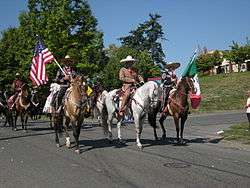
While Mexican Americans were once concentrated in the Southwest: California, Arizona, New Mexico, Colorado and Texas, during World War I they moved to industrial communities such as St. Louis, Chicago, Detroit, Cleveland, Pittsburgh, and other steel-producing regions, where they gained industrial jobs. Like European immigrants, they were attracted to work that did not require proficiency in English. Industrial restructuring in the second half of the century put many Mexican Americans out of work in addition to people of other ethnic groups. Their industrial skills were not as useful in the changing economies of these areas.
During the first half of the 20th century, Mexican-American workers formed unions of their own and joined integrated unions. The most significant union struggle involving Mexican Americans was the effort to organize agricultural workers and the United Farm Workers' long strike and boycott aimed at grape growers in the San Joaquin and Coachella valleys in the late 1960s. Leaders César Chávez and Dolores Huerta gained national prominence as they led a workers' rights organization that helped workers get unemployment insurance to an effective union of farmworkers almost overnight. The struggle to protect rights and sustainable wages for migrant workers has continued.
Since the late 20th century, Mexican illegal immigrants have increasingly become a large part of the workforce in industries such as meat packing, where processing centers have moved closer to ranches in relatively isolated rural areas of the Midwest; in agriculture in the southeastern United States; and in the construction, landscaping, restaurant, hotel and other service industries throughout the country.
.jpg)
Mexican-American identity has changed throughout these years. Over the past hundred years, activist Mexican Americans have campaigned for their constitutional rights as citizens, to overturn discrimination in voting and to gain other civil rights. They have opposed educational and employment discrimination, and worked for economic and social advancement. In numerous locations, court cases have been filed under the Voting Rights Act of 1965 to challenge practices, such as poll taxes and literacy tests in English, that made it more difficult for Spanish-language minorities to register and vote. At the same time, many Mexican Americans have struggled with defining and maintaining their community's cultural identity as distinct from mainstream United States. That changes in response to the absorption of countless new immigrants.
In the 1960s and 1970s, some Latino/Hispanic student groups flirted with Mexican nationalism, and differences over the proper name for members of the community. Discussion over self-identification as Chicano/Chicana, Latino/Latina, Mexican Americans, or Hispanics became tied up with deeper disagreements over whether to integrate into or remain separate from mainstream American society. There were divisions between those Mexican Americans whose families had lived in the United States for two or more generations and more recent immigrants, in addition to distinctions from other Hispanic or Latino immigrants from nations in Central and South America with their own distinct cultural traditions.
During this period, civil rights groups such as the National Mexican-American Anti-Defamation Committee were founded. By the early 21st century, the states with the largest percentages and populations of Mexican Americans are California, Arizona, New Mexico, Texas, Colorado, Nevada, and Utah. There have also been markedly increasing populations in Oklahoma, Pennsylvania and Illinois.[18]
In terms of religion, Mexican Americans are primarily Roman Catholic. A large minority are Evangelical Protestants. Notably, according to a Pew Hispanic Center report in 2006 and the Pew Religious Landscape Survey in 2008, Mexican Americans are significantly less likely than other Hispanic groups to abandon Catholicism for Protestant churches.[19][20]
Race and ethnicity
Ethnically, Mexican Americans are a diverse population, including those of European ancestry (mostly Spanish), Indigenous ancestry, a mixture of both, and Mexicans of Middle Eastern descent (mainly Lebanese). The Mexican population is majority mestizo, made up of individuals of mixed European and Native American indigenous ancestry.
Per the 2010 US Census, the majority (52.8%) of Mexican Americans identified as being White.[21] The remainder identified themselves as being of "some other race" (39.5%), "two or more races" (5.0%), Native American (1.4%), black (0.9%), and Asian / Pacific Islander (0.4%).[21] versus Mexico.
This identification as "some other race" reflects activism among Mexican Americans as claiming a cultural status and working for their rights in the United States, as well as the separation due to different language and culture. Hispanics are not a racial classification, however, but an ethnic group.
In the 21st century, studies in Mexico by national Mexican institutes of Mexican genetic admixture have established that a high proportion of the Mexican population has predominately European ancestry. In some studies the population is shown to be majority European, comparable to South American countries in which a higher proportion of the population has traditionally been classified as European or 'white.' There is genetic asymmetry, with the direct paternal line predominately European and the maternal line predominately Amerindian.
For instance, a 2006 study conducted by Mexico's National Institute of Genomic Medicine (INMEGEN), which genotyped 104 samples, reported that mestizo Mexicans are 58.96% European, 35.05% "Asian" (primarily Amerindian), and 5.03% Other.[22] According to a 2009 report by the Mexican Genome Project, which sampled 300 mestizos from six Mexican states and one indigenous group, the gene pool of the Mexican mestizo population was calculated to be 55.2% percent indigenous, 41.8% European, 1.0% African, and 1.2% Asian.[23] A 2012 study published by the Journal of Human Genetics found the deep paternal ancestry of the Mexican mestizo population to be predominately European (64.9%) followed by Amerindian (30.8%) and Asian (1.2%).[24] A 2013 study published by the American Journal of Physical Anthropology found the maternal ancestry of the Mexican mestizo population to be predominately Amerindian (92.9%) followed by European (5.3%) and African (1.9%).[25] In 2011 a large-scale mitochondrial sequencing in Mexican Americans revealed 85 to 90% of maternal mtDNA lineages are of Native American origin, with the remainder having European (5-7%) or other ancestry (3-5%).[26]
"White" Mexicans have been thought to be those persons of full European descent[27] but it is more likely that these are people of traditional European features. Although Mexico does not have a racial census, some international organizations believe that Mexican people of Spanish or predominantly European descent make up approximately one-sixth (16.5%) of the country's population, a figure which includes descendants of European immigrants since the late 19th and 20th centuries.[28] The "mestizos" include persons of varying amounts of European ancestry, and some have a European admixture higher than 90%.[29] Because of the high proportion of proven European genetic ancestry among mestizos, the Mexican government decided to abandon racial classifications as having little meaning in defining "white" and "mestizo". Instead, it decided to classify the population by ethnicities related to the primary languages spoken by groups, whether Spanish or indigenous languages. This also follows how people identify culturally.[27]
Classification of the contemporary ethnic populations by visible characteristics or self-identification yielded a modern white population of Mexico of 9-16%, but genetic studies have shown that Mexico has a population with a European admixture comparable to countries that report white populations of 52% - 77% (Chile and Costa Rica have averages of 51%.[30] and 60%, respectively.)[31] Studies in the general Mexican population have found European ancestry ranging from 56%[32] going to 60%,[33] 64%[34] and up to 78%[35]). The differences between genetic ancestry and reported numbers by self-identification in ethnic groups could be attributed to the influence of the concept known as "mestizaje", which was promoted by the post-revolutionary government in an effort to create a united Mexican cultural identity with no racial distinctions.[36]
US census bureau classifications
As the United States' borders expanded, the United States Census Bureau changed its racial classification methods for Mexican Americans under United States jurisdiction. The Bureau's classification system has evolved significantly from its inception:
- From 1790 to 1850, there was no distinct racial classification of Mexican Americans in the US census. The categories recognized by the Census Bureau were White, Mulatto, Free People of Color, and Black. Mulatto and black were both terms used to classify slaves, revealing recognition that many slaves were of mixed ancestry, generally due to European fathers. The Census Bureau estimates that during this period the number of persons who could not be categorized as white or black did not exceed 0.25% of the total population based on 1860 census data.[37]
- From 1850 through 1920 the Census Bureau expanded its racial categories to include multi-racial persons, under Mestizos, Mulattos, as well as new categories of distinction of Amerindians and Asians. It classified Mexicans and Mexican Americans as "White".[37]
- The 1930 US census revoked generic white status for Mexican Americans due to protests among certain parts of the population over a diluted definition of "whiteness." This decision followed a period in which Virginia and some other racially segregated states passed laws imposing binary classification and the one-drop rule, requiring classification of all persons with any known African ancestry as "black." The new form asked for "color or race." Census workers were instructed to differentiate between European whites and known people of Mexican descent, and to "write ‘W’ for White; and ’Mex’ for Mexican." [38] At the same time, the classification of Mulatto was dropped, as if to hide the extensive (and historically known) interrelationships between European Americans and African Americans, often involuntary.
- In the 1940 census, due to widespread protests by the Mexican American community following the 1930 changes, Mexican Americans were re-classified as White, . Instructions for enumerators were: "Mexicans – Report 'White' (W) for Mexicans unless they are definitely of indigenous or other non-white race." During the same census, however, the bureau began to track the White population of Spanish mother tongue. This practice continued through the 1960 census.[37] The 1960 census also used the title "Spanish-surnamed American" in their reporting data of Mexican Americans; this category also covered Cuban Americans, Puerto Ricans and others under the same category.
- From 1970 to 1980, there was a dramatic increase in the number of people who identified as "of Other Race" in the census, reflecting the addition of a question on 'Hispanic origin' to the 100-percent questionnaire, an increased propensity for Hispanics to identify as other than White as they agitated for civil rights, and a change in editing procedures to accept reports of "Other race" for respondents who wrote in ethnic Hispanic entries, such as Mexican, Cuban, or Puerto Rican. In 1970, such responses in the Other race category were reclassified and tabulated as White. During this census, the bureau attempted to identify all Hispanics by use of the following criteria in sampled sets:[37]
- Spanish speakers and persons belonging to a household where the head of household was a Spanish speaker
- persons with Spanish heritage by birth location or surname
- Persons who self-identified Spanish origin or descent
- From 1980 on, the Census Bureau has collected data on Hispanic origin on a 100-percent basis. The bureau has noted an increasing number of respondents who identify as of Hispanic origin but not of the White race.[37]
For certain purposes, respondents who wrote in "Chicano" or "Mexican" (or indeed, almost all Hispanic origin groups) in the "Some other race" category were automatically re-classified into the "White race" group.[39]
Politics and debate of racial classification
In some cases, legal classification of white racial status has made it difficult for Mexican-American rights activists to prove minority discrimination. In the case Hernandez v. Texas (1954), civil rights lawyers for the appellant, named Pedro Hernandez, were confronted with a paradox: because Mexican Americans were classified as white by the federal government and not as a separate race in the census, lower courts held that they were not being denied equal protection by being tried by juries that excluded Mexican Americans by practice. The lower court ruled there was no violation of the Fourteenth Amendment by excluding people with Mexican ancestry among the juries. Attorneys for the state of Texas and judges in the state courts contended that the amendment referred only to racial, not "nationality," groups. Thus, since Mexican Americans were tried by juries composed of their racial group—whites—their constitutional rights were not violated. The US Supreme Court ruling in Hernandez v. Texas case held that "nationality" groups could be protected under the Fourteenth Amendment, and it became a landmark in the civil rights history of the United States.[40]
While Mexican Americans were allowed to serve in all-white units during World War II, many Mexican–American veterans were discriminated against and even denied medical services by the United States Department of Veterans Affairs when they arrived home. They created the G.I. Forum to work for equal treatment.[41]
In times and places in the United States where Mexicans were classified as white, they were permitted by law to intermarry with what today are termed "non-Hispanic whites." Social customs typically approved of such marriages only if the Mexican partner was not of visible indigenous ancestry.[42]
Legally, Mexican Americans could vote and hold elected office; however, in many states electoral practices discriminated against them, especially as a language minority. After they created political organizations such as the League of United Latin America Citizens and the G.I. Forum, Mexican Americans began to exert more political influence and gain elective office. Edward Roybal's election to the Los Angeles City Council in 1949 and to Congress in 1962 also represented this rising Mexican-American political power.
In the late 1960s the founding of the Crusade for Justice in Denver and the land grant movement in New Mexico in 1967 set the bases for what would become known as Chicano (Mexican American) nationalism. The 1968 Los Angeles, California school walkouts expressed Mexican-American demands to end de facto ethnic segregation (also based on residential patterns), increase graduation rates, and reinstate a teacher fired for supporting student political organizing. A notable event in the Chicano movement was the 1972 Convention of La Raza Unida (United People) Party, which organized with the goal of creating a third party to give Chicanos political power in the U.S.[41]
In the past, Mexicans were legally considered "White" because either they were accepted as being of Spanish ancestry, or because of early treaty obligations to Spaniards and Mexicans that conferred citizenship status to Mexican peoples before the American Civil War. Numerous slave states bordered Mexican territory at a time when 'whiteness' was nearly a prerequisite for US citizenship in those states.[43][44]
Although Mexican Americans were legally classified as "White" in terms of official federal policy, many organizations, businesses, and homeowners associations and local legal systems had official policies in the early 20th century to exclude Mexican Americans in a racially discriminatory way.[45] Throughout the Southwest, discrimination in wages was institutionalized in "white wages" versus lower "Mexican wages" for the same job classifications.[45] For Mexican Americans, opportunities for employment were largely limited to guest worker programs.[45]
The bracero program, begun in 1942 during World War II, when many United States men were drafted for war, allowed Mexicans temporary entry into the U.S. as migrant workers at farms throughout California and the Southwest. This program continued until 1964.[22][46][47]
A number of western states passed anti-miscegenation laws, directed chiefly at Chinese and Japanese. As Mexican Americans were then classified as "white" by the census, they could not legally marry African or Asian Americans (See Perez v. Sharp). According to historian Neil Foley in his book The White Scourge: Mexicans, Blacks, and Poor Whites in Texas Cotton Culture, Mexicans and Mexican-Americans in Texas did marry non-whites, typically without reprisal.[48]
While of racial segregation and discrimination against both Mexican American and African American minorities were subject to segregation and racial discrimination, they were treated differently. There were legal racial demarcations between whites and blacks in a state like Texas, whereas the line between whites and Mexican Americans was not legally defined. Mexican Americans could attend white schools and colleges (which were racially segregated against blacks), mix socially with whites and, marry whites. These choices were prohibited to African Americans under state laws. Racial segregation operated separately from economic class and was rarely as rigid for Mexican Americans as it was for African Americans. For instance, even when some African Americans in Texas enjoyed higher economic status than Mexican Americans (or whites) in an area, they were still segregated by law.[49]
Economic and social issues
Immigration issues
- See also Strangers No Longer: Together on the Journey of Hope, a pastoral letter written by both the United States Conference of Catholic Bishops and the Mexican Episcopal Conference, which deals with the issue of migration in the context of the United States and Mexico.
Since the 1960s, Mexican immigrants have met a significant portion of the demand for cheap labor in the United States.[50] Fear of deportation makes them highly vulnerable to exploitation by employers. Many employers, however, have developed a "don't ask, don't tell" attitude toward hiring undocumented Mexican nationals. In May 2006, hundreds of thousands of undocumented immigrants, Mexicans and other nationalities, walked out of their jobs across the country in protest to support immigration reform (many in hopes of a path to citizenship similar to the Immigration Reform and Control Act of 1986 signed into law by President Ronald Reagan, which granted citizenship to Mexican nationals living and working without documentation in the US).

Even legal immigrants to the United States, both from Mexico and elsewhere, have spoken out against illegal immigration. However, according to a survey conducted by the Pew Research Center in June 2007, 63% of Americans would support an immigration policy that would put illegal immigrants on a path to citizenship if they "pass background checks, pay fines and have jobs, learn English", while 30% would oppose such a plan. The survey also found that if this program was instead labeled "amnesty", 54% would support it, while 39% would oppose.[51]
Alan Greenspan, former Chairman of the Federal Reserve, has said that the growth of the working-age population is a large factor in keeping the economy growing and that immigration can be used to grow that population. According to Greenspan, by 2030, the growth of the US workforce will slow from 1 percent to 1/2 percent, while the percentage of the population over 65 years will rise from 13 percent to perhaps 20 percent.[52] Greenspan has also stated that the current immigration problem could be solved with a "stroke of the pen", referring to the Comprehensive Immigration Reform Act of 2007 which would have strengthened border security, created a guest worker program, and put illegal immigrants currently residing in the US on a path to citizenship if they met certain conditions.[53]
According to data published by the Bank of Mexico, Mexicans in the United States sent $24.7 billion dollars in remittances to Mexico in 2015.[54]
Discrimination and stereotypes
Throughout US history, Mexican Americans have and continue to endure various types of negative stereotypes which have long circulated in media and popular culture.[55][56] Mexican Americans have also faced discrimination based on ethnicity, race, culture, poverty, and use of the Spanish language.[57]
Since the majority of illegal immigrants in the US have traditionally been from Latin America, the Mexican American community has been the subject of widespread immigration raids. During The Great Depression, the United States government sponsored a Mexican Repatriation program which was intended to encourage people to voluntarily move to Mexico, but thousands were deported against their will. More than 500,000 individuals were deported, approximately 60 percent of which were actually United States citizens.[58][59] In the post-war McCarthy era, the Justice Department launched Operation Wetback.[59]
During World War II, more than 300,000 Mexican Americans served in the US armed forces.[16] Mexican Americans were generally integrated into regular military units; however, many Mexican–American War veterans were discriminated against and even denied medical services by the United States Department of Veterans Affairs when they arrived home.[22] In 1948, war veteran Hector P. Garcia founded the American GI Forum to address the concerns of Mexican American veterans who were being discriminated against. The AGIF's first campaign was on the behalf of Felix Longoria, a Mexican American private who was killed in the Philippines while in the line of duty. Upon the return of his body to his hometown of Three Rivers, Texas, he was denied funeral services because of his nationality.
In the 1948 case of Perez v. Sharp, the Supreme Court of California recognized that interracial bans on marriage violated the Fourteenth Amendment of the Federal Constitution. The case involved Andrea Perez, a Mexican-American woman listed as White, and Sylvester Davis, an African American man.
In 2006, Time magazine reported that the number of hate groups in the United States increased by 33% since 2000, with illegal immigration being used as a foundation for recruitment.[60] According to the 2011 Federal Bureau of Investigation (FBI) Hate Crimes Statistics Report, 56.9% of the 939 victims of crimes motivated by a bias toward the victims’ ethnicity or national origin were directed at Hispanics.[61] In California, the state with the largest Mexican American population, the number of hate crimes committed against Latinos has almost doubled from 2003 to 2007.[62][63] In 2011, hate crimes against Hispanics declined 31% in the United States and 43% in California.[64]
Social status and assimilation

Barrow (2005) finds increases in average personal and household incomes for Mexican Americans in the 21st century. US-born Americans of Mexican heritage earn more and are represented more in the middle and upper-class segments more than most recently arriving Mexican immigrants.
Most immigrants from Mexico, as elsewhere, come from the lower classes and from families generationally employed in lower skilled jobs. They also are most likely from rural areas. Thus, many new Mexican immigrants are not skilled in white collar professions. Recently, some professionals from Mexico have been migrating, but to make the transition from one country to another involves re-training and re-adjusting to conform to US laws —i.e. professional licensing is required.
According to James P. Smith of the Research and Development Corporation, the children and grandchildren of Latino immigrants tend to lessen educational and income gaps with White American. Immigrant Latino men earn about half of what whites make, while second generation US-born Latinos make about 78 percent of the salaries of their white counterparts and by the third generation US-born Latinos make on average identical wages to their US-born white counterparts.[65] However, the number of Mexican American professionals have been growing in size since 2010.[66]
Huntington (2005) argues that the sheer number, concentration, linguistic homogeneity, and other characteristics of Latin American immigrants will erode the dominance of English as a nationally unifying language, weaken the country's dominant cultural values, and promote ethnic allegiances over a primary identification as an American. Testing these hypotheses with data from the US Census and national and Los Angeles opinion surveys, Citrin et al. (2007) show that Hispanics generally acquire English and lose Spanish rapidly beginning with the second generation, and appear to be no more or less religious or committed to the work ethic than native-born non-Mexican American whites. However, the children and grandchildren of Mexican immigrants were able to make close ties with their extended families in Mexico, since United States shares a 2,000 mile border with Mexico. Many had the opportunity to visit Mexico on a relatively frequent basis. As a result, many Mexicans were able to maintain a strong Mexican culture, language, and relationship with others.[67]
South et al. (2005) examine Hispanic spatial assimilation and inter-neighborhood geographic mobility. Their longitudinal analysis of seven hundred Mexican, Puerto Rican, and Cuban immigrants followed from 1990 to 1995 finds broad support for hypotheses derived from the classical account of assimilation into American society. High income, English-language use, and embeddedness in American social contexts increased Latin American immigrants' geographic mobility into multi-ethnic neighborhoods. US citizenship and years spent in the United States were positively associated with geographic mobility into different neighborhoods while co-ethnic contact and prior experiences of ethnic discrimination decreased the likelihood that Latino immigrants would move from their original neighborhoods and into non-Hispanic White census tracts.[68]
Intermarriage
According to 2000 census data, US-born ethnic Mexicans have a high degree of intermarriage with non-Hispanic Whites. Based on a sample size of 38,911 U.S.-born Mexican husbands and 43,527 U.S.-born Mexican wives:[69]
- 50.6% of US-born Mexican men and 45.3% of US-born Mexican women married US-born Mexicans;[69]
- 26.7% of US-born Mexican men and 28.1% of US-born Mexican women married non-Hispanic Whites; and[69]
- 13.6% of US-born Mexican men and 17.4% of US-born Mexican women married Mexico-born Mexicans.[69]
In addition, based on 2000 data, there is a significant amount of ethnic absorption of ethnic Mexicans into the mainstream population with 16% of the children of mixed marriages not being identified in the census as Mexican.[70]
Segregation issues
Housing market practices
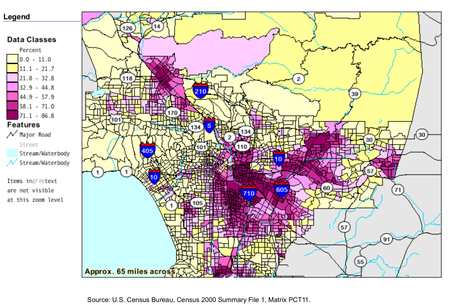
Studies have shown that the segregation among Mexican Americans and Mexican immigrants seems to be declining. One study from 1984 found that Mexican American applicants were offered the same housing terms and conditions as non-Hispanic White Americans. They were asked to provide the same information (regarding employment, income, credit checks, etc.) and asked to meet the same general qualifications of their non-Hispanic White peers.[71] In this same study, it was found that Mexican Americans were more likely than non-Hispanic White Americans to be asked to pay a security deposit or application fee[71] and Mexican American applicants were also more likely to be placed onto a waiting list than non-Hispanic White applicants.[71]
Latino segregation versus Black segregation
When comparing the contemporary segregation of Mexican Americans to that of Black Americans, some scholars claim that "Latino segregation is less severe and fundamentally different from Black residential segregation." suggesting that the segregation faced by Latinos is more likely to be due to factors such as lower socioeconomic status and immigration while the segregation of African Americans is more likely to be due to larger issues of the history of racism in the US.[72]
Legally, Mexican Americans could vote and hold elected office, however, it was not until the creation of organizations such as the League of United Latin America Citizens and the G.I. Forum that Mexican Americans began to achieve political influence. Edward Roybal's election to the Los Angeles City Council in 1949 and then to Congress in 1962 also represented this rising Mexican American political power. In the late 1960s the founding of the Crusade for Justice in Denver in and the land grant movement in New Mexico in 1967 set the bases for what would become the Chicano (Mexican American) nationalism. The 1968 Los Angeles school walkouts expressed Mexican American demands to end segregation, increase graduation rates, and reinstate a teacher fired for supporting student organizing. A notable event in the Chicano movement was the 1972 Convention of La Raza Unida (United People) Party, which organized with the goal of creating a third party that would give Chicanos political power in the U.S.[41]
In the past, Mexicans were legally considered "White" because either they were considered to be of full Spanish heritage, or because of early treaty obligations to Spaniards and Mexicans that conferred citizenship status to Mexican peoples at a time when whiteness was a prerequisite for US citizenship.[43][44] Although Mexican Americans were legally classified as "White" in terms of official federal policy, many organizations, businesses, and homeowners associations and local legal systems had official policies to exclude Mexican Americans. Throughout the southwest discrimination in wages were institutionalized in "white wages" versus lower "Mexican wages" for the same job classifications. For Mexican Americans, opportunities for employment were largely limited to guest worker programs. The bracero program, which began in 1942 and officially ended in 1964, allowed them temporary entry into the U.S. as migrant workers in farms throughout California and the Southwest.[22][45][46][47]
Mexican Americans legally classified as "White", following anti-miscegenation laws in most western states until the 1960s, could not legally marry African or Asian Americans (See Perez v. Sharp). However, most were not socially considered white, and therefore, according to Historian Neil Foley in the book The White Scourge: Mexicans, Blacks, and Poor Whites in Texas Cotton Culture, Mexicans and Mexican-Americans did marry non-whites typically without reprisal.
Despite the similarities between Mexican American and African American patterns of segregation, there were important differences. The racial demarcations between whites and blacks in a state like Texas were inviolable, whereas those between whites and Mexican Americans were not. It was possible for Mexican Americans to attend white schools and colleges, mix socially with whites and, on occasion, marry whites: all of these things were impossible for African Americans, largely due to the legalized nature of black-white segregation. Racial segregation was rarely as rigid for Mexican Americans as it was for African Americans, even in situations where African Americans enjoyed higher economic status than Mexican Americans.[49]
Segregated schools
During certain periods, Mexican American children sometimes were forced to register at "Mexican schools", where classroom conditions were poor, the school year was shorter, and the quality of education was substandard.[73]
Various reasons for the inferiority of the education given to Mexican American students have been listed by James A. Ferg-Cadima including: inadequate resources, poor equipment, unfit building construction. In 1923, the Texas Education Survey Commission found that the school year for some non-white groups was 1.6 months shorter than the average school year.[73] Some have interpreted the shortened school year as a "means of social control" implementing policies to ensure that Mexican Americans would maintain the unskilled labor force required for a strong economy. A lesser education would serve to confine Mexican Americans to the bottom rung of the social ladder. By limiting the number of days that Mexican Americans could attend school and allotting time for these same students to work, in mainly agricultural and seasonal jobs, the prospects for higher education and upward mobility were slim.[73]
Immigration and segregation
Immigration hubs are popular destinations for Latino immigrants. These segregated areas have historically served the purpose of allowing immigrants to become comfortable in the United States, accumulate wealth, and eventually leave.[74]
This model of immigration and residential segregation, explained above, is the model which has historically been accurate in describing the experiences of Latino immigrants. However, the patterns of immigration seen today no longer follows this model. This old model is termed the standard spatial assimilation model. More contemporary models are the polarization model and the diffusion model: The spatial assimilation model posits that as immigrants would live within this country's borders, they would simultaneously become more comfortable in their new surroundings, their socioeconomic status would rise, and their ability to speak English would increase. The combination of these changes would allow for the immigrant to move out of the barrio and into the dominant society. This type of assimilation reflects the experiences of immigrants of the early twentieth century.[72]
Polarization model suggests that the immigration of non-Black minorities into the United States further separates Blacks and Whites, as though the new immigrants are a buffer between them. This creates a hierarchy in which Blacks are at the bottom, Whites are at the top, and other groups fill the middle. In other words, the polarization model posits that Asians and Hispanics are less segregated than their African American peers because White American society would rather live closer to Asians or Hispanics than African Americans.[74]
The diffusion model has also been suggested as a way of describing the immigrant's experience within the United States. This model is rooted in the belief that as time passes, more and more immigrants enter the country. This model suggests that as the United States becomes more populated with a more diverse set of peoples, stereotypes and discriminatory practices will decrease, as awareness and acceptance increase. The diffusion model predicts that new immigrants will break down old patterns of discrimination and prejudice, as one becomes more and more comfortable with the more diverse neighborhoods that are created through the influx of immigrants.[74] Applying this model to the experiences of Mexican Americans forces one to see Mexican American immigrants as positive additions to the "American melting pot," in which as more additions are made to the pot, the more equal and accepting society will become.
The Chicano movement and the Chicano Moratorium
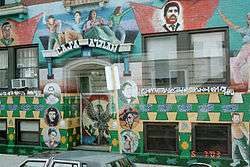
In the heady days of the late 1960s, when the student movement was active around the globe, the Chicano movement conducted actions such as the mass walkouts by high school students in Denver and East Los Angeles in 1968 and the Chicano Moratorium in Los Angeles in 1970. The movement was particularly strong at the college level, where activists formed MEChA, an organization that seeks to promote Chicano unity and empowerment through education and political action, but also espouses revanchist ideals centered around "taking back" the American southwest for Mexicans.
The Chicano Moratorium, formally known as the National Chicano Moratorium Committee, was a movement of Chicano anti-war activists that built a broad-based but fragile coalition of Mexican-American groups to organize opposition to the Vietnam War. The committee was led by activists from local colleges and members of the "Brown Berets", a group with roots in the high school student movement that staged walkouts in 1968, known as the East L.A. walkouts, also called "blowouts".
The best known historical fact of the Moratorium was the death of Rubén Salazar, known for his reporting on civil rights and police brutality. The official story is that Salazar was killed by a tear gas canister fired by a member of the Los Angeles County Sheriff's Department into the Silver Dollar Café at the conclusion of the August 29 rally.
Education
Parental Involvement

Parents are commonly associated with being a child’s first teacher. As the child grows older, the parent’s role in their child’s learning may change; however, a parent will often continue to serve as a role model. There are multiple research articles that have looked at parental involvement and education. A key aspect of parental involvement in education is that it can be transmitted in many ways. For a long time, there has been a misconception that the parents of Mexican American students are not involved in their children’s education; however, multiple studies have demonstrated that parents are involved in their children’s education (Valencia & Black, 2002).[75] It is important to know that the parents of Mexican American students frequently display their involvement through untraditional methods; such as, consejos, home-base practices, and high academic expectations.
Literature has demonstrated that parental involvement has had a positive influence in the academic achievement of Mexican American students. Studies have shown that Mexican families show their value towards education by using untraditional methods (Kiyama, 2011).[76] One educational practice that is commonly used among Mexican families are consejos (advice). Additional research has supported the idea that parents’ consejos have had a significant influence on the education of Mexican American students. Espino (2016)[77] studied the influence that parental involvement had on seven, 1st generation Mexican American PhDs. The study found that one of the participant’s father would frequently use consejos to encourage his son to continue his education. The father’s consejos served as an encouragement tool, which motivated the participant to continue his education. Consejos are commonly associated with the parents’ occupation. Parents use their occupation as leverage to encourage their child to continue his or her education, or else they may end up working an undesirable job (Espino, 2016). While this might not be the most common form of parental involvement, studies have shown that it has been an effective tool that encourages Mexican American students.
Another study emphasized the importance of home-based parental involvement. Altschul (2011)[78] conducted a study that tested the effects of six different types of parental involvement and their effect on Mexican American students. The study used previous data from the National Education Longitudinal Study (NELS) of 1988. The data was used to evaluate the influence of parental practices in the 8th grade and their effect on students once they were in the 10th grade. Altschul (2011) noted that home-based parental involvement had a more positive effect on the academic achievement of Mexican American students, than involvement in school organizations. The literature suggests that parental involvement in the school setting is not necessary, parents can impact the academic achievement of their children from their home.
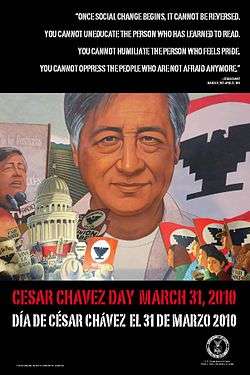
Additional literature has demonstrated that parent involvement also comes in the form of parent expectations. Valencia and Black (2002) argued that Mexican parents place a significant amount of value on education and hold high expectations for their children. The purpose of their study was to debunk the notion that Mexicans do no value education by providing evidence that shows the opposite. Setting high expectations and expressing their desire for their children to be academically successful has served as powerful tools to increase of the academic achievement among Mexican American students (Valencia & Black, 2002). Keith and Lichtman (1995)[79] also conducted a research study that measured the influence of parental involvement and academic achievement. The data was collected from the NELS and used a total of 1,714 students that identified as Mexican American (Chicana/o). The study found a higher level of academic achievement among 8th grade Mexican American students and parents who had high educational aspirations for their children (Keith & Lichtman, 1995). Additional research done by Carranza, You, Chhuon, and Hudley (2009)[80] added support to the idea that high parental expectations were associated with higher achievement levels among Mexican American students. Carranza et al. (2009) studied 298 Mexican American high school students. They studied whether perceived parental involvement, acculturation, and self-esteem had any effect on academic achievement and aspirations. Results from their study demonstrated that perceived parental involvement had an influence on the students’ academic achievement and aspirations. Additionally, Carranza et al. noted that among females, those who perceived that their parents expected them to get good grades tended to study more and have higher academic aspirations (2009). The findings suggest that parental expectations can affect the academic performance of Mexican American students.
Based on current literature, one can conclude that parental involvement is an extremely important aspect of Mexican American students’ education. The studies demonstrated that parental involvement is not limited to participating in school activities at the school; instead, parental involvement can be displayed through various forms. There are numerous studies that suggest that parental expectations are associated with the achievement level of Mexican American students. Future research should continue to study the reasons why Mexican American students perform better when their parents expect them to do well in school. Furthermore, future research can also look into whether gender influences parental expectations.
Mexican American communities
Large Mexican American populations by both size and per capita exist in the following American cities:
- Los Angeles, California – the city proper home to over 1.2 million of Mexican ancestry, another 2.3 million throughout Los Angeles County, and a total of about 6.3 million in the five-county Greater Los Angeles Area. Largest Mexican ancestry populated city in the United States. (according to the 2010 census, L.A. is now 31.9% of Mexican descent with numerous Central American national groups).
- East Los Angeles, California – Unincorporated community of roughly 130,000, name synonymous with Mexican Americans, 97% Hispanic, 88% of Mexicans are immigrant, 40% of east L.A. residents reportedly Mexican including American-born.[81]
- Culver City, California – Also the site of the infamous Zoot Suit Riots in 1943.
- Long Beach, California – Third largest city in Southern California, One of many cities in the region with a large Mexican/Hispanic population.
- Pomona – over 75% Latino, 60% of the city population is Mexican or Mexican American.
- La Puente, California – about two-thirds are of Mexican ancestry or Hispanic, one of the largest Hispanic (in percentage, the most Mexican-American community) populations in California.
- Downey, California - Between 45-50% are of Mexican descent.
- Inland Empire, California (Riverside/ San Bernardino Counties- and the cities of that namesake) – About a third of the population are of Mexican descent.
- Riverside, California[82] and San Bernardino, California[82]
- Indio, California[82] and Coachella, California (primarily Mexican-American).[83]
- Southern California is the highest densely populated Mexican-American region, but by areas of percentage it is South Texas.
- Las Vegas, Nevada – 31% of the population of the city is Hispanic in which 24% of that is of Mexican descent.
- Chicago – Over 1.5 million of Mexican ancestry in the Chicago metropolitan area[82] and the fourth largest Mexican community in the USA.
- Phoenix, Arizona – fifth largest Mexican-American population.
- Tucson – 30% of the almost 1 million people in the metro area.[84]
- Dallas/Fort Worth Area – fifth largest Mexican-American population and over 1.5 million Mexicans in the Dallas–Fort Worth Metroplex (3rd largest foreign born Mexican population in the US per MSA).
- San Antonio, Texas – over half of the population in the city proper (53.2%, 705,530) and second largest Mexican population of any city in the US.[82]
- San Francisco Bay Area – also with over one million Hispanics, many of whom are Mexican Americans, both US-born and foreign-born (see also Oakland about 10–20% Hispanic and San Francisco – the Mission District section- the city is 10–20% Latino).
- Oakland – California's third largest Mexican-American city by percentage (over 25%) after Long Beach (about 30%). Many live in the Fruitvale district.
- San Jose, California – Nearly one-third of the city's population is Mexican-American or of Hispanic origin; San Jose has the largest Mexican-American population within the Bay Area.
- Houston, Texas – Third largest Mexican ancestry community in the United States.[85]
- San Diego, California – slightly less than one-third of the city's population is Hispanic, primarily Mexican American; however, this percentage is the lowest of any significant border city.
- El Paso, Texas – largest Mexican-American community bordering a state of Mexico.
- South Texas – Heavily populated by Mexican-Americans, who are the ethnic majority, in a region spanning from Laredo to Corpus Christi to Brownsville.
- Central Valley of California both the Sacramento and San Joaquin Valleys have majority Mexican American communities.
- Denver, Colorado – Colorado has the eighth largest population of Hispanics, seventh high percentage of Hispanics, fourth largest population of Mexican-Americans, and sixth highest percentage of Mexican-Americans in the United States. According to the 2010 census, there are over 1 million Mexican-Americans in Colorado.[86] Over one-third of the city's population is Mexican-American or Hispanic/Latino, as well as approximately one-fourth of the entire Denver Metropolitan area. About 17% of the cities population is foreign born, mostly from Latin America.
- Greeley, Colorado – Over one-third of the city's population is Latino, mostly Mexican-American.
- Garden City is Latino majority, and Evans has a very large Latino population as well.
- Southern Colorado is home to many communities of Hispanics descended from Mexican settlers who arrived during Spanish colonial times. Roughly half of Pueblo's population is Latino, mostly Mexican-American. Many other towns in southern Colorado have high proportions of Mexican-Americans. La Junta, Rocky Ford, Las Animas, Lamar, Walsenburg, and Trinidad all have large Mexican American communities.
- San Luis Valley – The San Luis Valley has many towns with large Mexican-American populations. Antonito, Blanca, Center, Del Norte, Fort Garland, Monte Vista, and Romeo are all Latino majority.[87]
- The Yakima Valley and Tri-Cities, Washington – This region of Washington contains many communities of Mexican-American majority thanks to high demand for agricultural labor.
Major US destinations
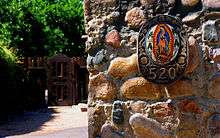
In the 1990s and 2000s, the Midwestern United States became a major destination for Mexican immigrants. But Mexican-Americans were already present in the Midwest's industrial cities and urban areas. Especially Mexicans/Latinos came into states like Illinois (mostly in Chicago and close-in suburbs), Indiana especially the Northern section, Iowa, Kansas, Michigan (Especially in the Western Portion of the state.), Minnesota, Missouri, Nebraska and Wisconsin due to needs of the region's industrial manufacturing base.
Another destination of Mexican and Latin American immigration was the Northeastern United States, in places such as the Monongahela Valley, Pennsylvania; Mahoning Valley, Ohio; throughout Massachusetts and the state of Rhode Island; New Haven, Connecticut along with other Latin American nationalities; Washington, D.C. with Maryland and Northern Virginia included; the Hudson Valley and Long Island of New York state; the Jersey Shore region and the Delaware Valley, New Jersey.
Communities that consist mostly of recent-arrived immigrants from Mexico, are also present in other parts of the rural Southeastern United States, in states such as Georgia, Maryland, Tennessee, Alabama, Arkansas and Oklahoma. A growing Mexican-American population is also present in urban areas such as Orlando, Florida with the Central Florida region included; the Atlanta metro area; Charlotte, North Carolina- with a majority Hispanic enclave of Eastland; New Orleans which increased after Hurricane Katrina in Sep. 2005; the Hampton Roads, Virginia area; the states of Maine, New Hampshire and Delaware; and Pennsylvania especially in the Philadelphia metropolitan area.
List of states by Mexican American population
| State/Territory | Mexican American Population (2010 Census)[85] | Percentage of State Population |
|---|---|---|
| | 122,911 | 2.6 |
| | 21,642 | 3.0 |
| | 1,657,668 | 25.9 |
| | 138,194 | 4.7 |
| | 11,423,146 | 30.7 |
| | 757,181 | 15.1 |
| | 50,658 | 1.4 |
| | 30,283 | 3.4 |
| | 8,507 | 1.4 |
| | 629,718 | 3.3 |
| | 519,502 | 5.4 |
| | 35,415 | 2.6 |
| | 148,923 | 9.5 |
| | 1,602,403 | 12.5 |
| | 295,373 | 4.6 |
| | 117,090 | 3.8 |
| | 247,297 | 8.7 |
| | 82,110 | 1.9 |
| | 78,643 | 1.7 |
| | 5,134 | 0.4 |
| | 88,004 | 1.5 |
| | 38,379 | 0.6 |
| | 317,903 | 3.2 |
| | 176,007 | 3.3 |
| | 52,459 | 1.8 |
| | 147,254 | 2.5 |
| | 20,048 | 2.0 |
| | 128,060 | 7.0 |
| | 540,978 | 20.8 |
| | 7,822 | 0.6 |
| | 217,715 | 2.5 |
| | 590,890 | 28.7 |
| | 457,288 | 2.4 |
| | 486,960 | 5.1 |
| | 9,223 | 1.4 |
| | 172,029 | 1.5 |
| | 267,016 | 7.1 |
| | 369,817 | 9.7 |
| | 129,568 | 1.0 |
| | 9,090 | 0.9 |
| | 138,358 | 3.0 |
| | 13,839 | 1.7 |
| | 186,615 | 2.9 |
| | 7,951,193 | 31.6 |
| | 258,905 | 9.4 |
| | 2,534 | 0.4 |
| | 155,067 | 1.9 |
| | 601,768 | 8.9 |
| | 9,704 | 0.5 |
| | 244,248 | 4.3 |
| | 37,719 | 6.7 |
| Total US | 31,798,258 | 10.3 |
Notable Mexican Americans
Historical Figures
-
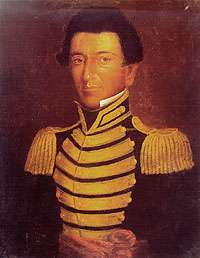
Juan Seguin, was a political and military figure of the Texas Revolution helping to establish the independence of Texas.[1]
-

Antonio Menchaca, was an American soldier and politician who fought in the Texas Revolution.
-
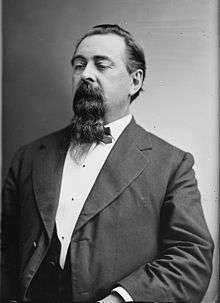
Romualdo Pacheco, became the 12th governor of California. He remains the first and only Latino Governor of California.
-

Octaviano Larrazolo, served as the fourth Governor of New Mexico and became the first Hispanic United States Senator.
-

Romana Acosta Bañuelos, became the first Hispanic Treasurer of the United States (1971–1974).
-
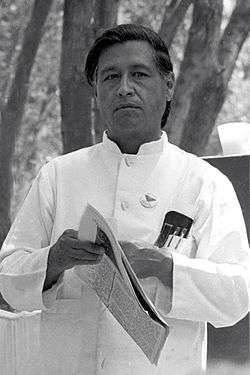
Cesar Chavez, a labor leader and civil rights activist, who, with Dolores Huerta, co-founded the United Farm Workers union, UFW).[2]
-
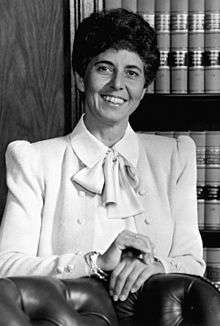
Rosemary Barkett became the first woman Chief Justice of the Florida Supreme Court and was the judge in the Iran – United States Claims Tribunal.
- ^ "Juan Seguin Biography". Encyclopedia Britannica.
- ^ "Cesar Chavez". Points of Light. Retrieved June 18, 2014.
Cinema
-

Myrtle Gonzalez, actress famous for her silent films in the 1910s, is considered the first female Latin star in Hollywood.[1]
-

Ramon Novarro, actor promoted by MGM as a "Latin lover" who became a leading man and one of the top box office attractions of the 1920s and early 1930s.
-

Lupe Vélez, a stage and film actress nicknamed The Mexican Spitfire by the media whose career spanned from the 1920s to the 1940s. She has a star on the Hollywood Walk of Fame.[2]
-

Gilbert Roland, film and television actor whose career spanned seven decades from the 1920s until the 1980s. He was twice nominated for the Golden Glove Award in 1952 and 1964, and inducted to the Hollywood Walk of Fame in 1960.[3]
-
Ricardo Montalban, actor whose career spanned seven decades, won an Emmy Award (1978), Screen Actors Guild (1993) and inducted in the Hollywood Walk of Fame.
-
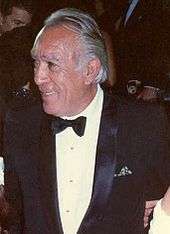
Anthony Quinn, actor, painter and writer. He starred in numerous critically acclaimed and commercially successful films. He won the Academy Award for Best Supporting Actor twice: for Viva Zapata! in 1952 and Lust for Life in 1956.
-

Eva Longoria actress, producer, director, and businesswoman. She is best known for her role as Gabrielle Solis on the ABC television series Desperate Housewives'. She received a Golden Globe Award and won two Screen Actors Guild Awards.
-

Lynda Carter actress, singer, songwriter and beauty pageant titleholder who was crowned Miss World America 1972 and also the star of the TV series Wonder Woman from 1975 to 1979.
-

Jessica Alba actress, model and businesswoman.
-
.jpg)
Uma Thurman actress and model She won a Golden Globe Award for the TV movie Hysterical Blindness.
-

Alexis Bledel actress and model
-
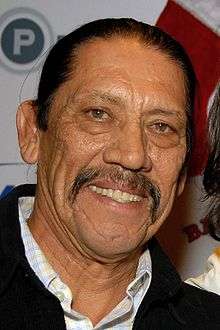
Danny Trejo actor who has appeared in numerous Hollywood films, often as villains and anti-heroes.
-

Salma Hayek actress, producer, and former model.
- ^ From Bananas to Buttocks. Retrieved 5 March 2015.
- ^ "Hollywood Star Walk: Lupe Velez". latimes.com. Retrieved April 18, 2015.
- ^ "Gilbert Roland". HOLLYWOOD WALK OF FAME. Retrieved January 1, 2015.
Music
-

Joan Baez, folk singer, songwriter, musician, and activist[1] whose contemporary folk music often includes songs of protest or social justice.[2]<ref>
-

Carlos Santana, named by Rolling Stone magazine as one of the greatest guitarists of all time.[3][4] He has won 10 Grammy Awards and three Latin Grammy Awards.[5]
-
.jpg)
Vikki Carr singer and humanitarian who has performed in a variety of music genres, including jazz, pop and country, but has enjoyed her greatest success singing in Spanish. She had 10 singles that made the US pop charts and 13 albums that made the US pop-album charts.
-
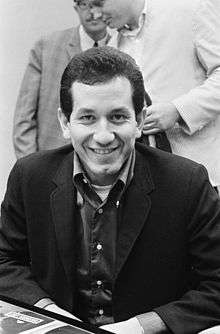
Trini Lopez, singer, guitarist, and actor who scored 13 chart singles through 1968. On the adult contemporary chart, he racked up 15 hits. He became one of the country's top nightclub performers of that era, regularly headlining in Las Vegas.
-

Linda Ronstadt, popular music singer. She has earned 11 Grammy Awards, three American Music Awards, two Academy of Country Music awards, an Emmy Award, an ALMA Award, and was inducted into the Rock and Roll Hall of Fame in April 2014.[6]
-

Demi Lovato, songwriter, actress and model who made her debut as a child actress in Barney & Friends. In 2008, Lovato rose to prominence in the Disney Channel television film Camp Rock and signed a recording contract with Hollywood Records.
-

Selena Gomez, actress and singer known for first featured on the children's series Barney & Friends in the early 2000s. She formed her band Selena Gomez & the Scene after signing a recording contract with Hollywood Records in 2008.
-

Hope Sandoval American singer-songwriter who is the lead singer for Mazzy Star and Hope Sandoval & the Warm Inventions.
-

Fergie Duhamel singer, songwriter and actress.
-
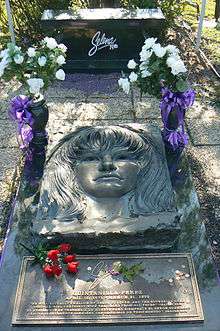
Selena Quintanilla Singer, songwriter, spokesperson, actress, and fashion designer, her contributions to music and fashion made her one of the most celebrated Mexican-American entertainers of the late 20th century. She also ranks the "top Latin artist of the '90s" and the "best selling Latin artist of the decade" and among the most influential Latin artists of all-time.
-
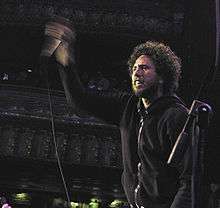
Zack de la Rocha American musician, poet, rapper, and activist best known as the vocalist and lyricist of rap metal band Rage Against the Machine from 1991–2000.
-

Robert Trujillo is an American musician known for his role as the current bassist of heavy metal band Metallica.
-
Ritchie Valens was an American singer, songwriter and guitarist and a rock and roll pioneer.
- ^ Westmoreland-White, Michael L. (February 23, 2003). "Joan Baez: Nonviolence, Folk Music, and Spirituality". Every Church A Peace Church. Archived from the original on July 22, 2004. Retrieved November 3, 2013.
- ^ Jackson, Ernie. "Folk Guitarists." Joelma
- ^ "100 Greatest Guitarists: Carlos Santana". Rolling Stone. Retrieved 2014-06-14.
- ^ "The 100 Greatest Guitar players of All Time''; ''Rolling Stone''". Rolling Stone. September 18, 2003. Archived from the original on March 7, 2010. Retrieved 2010-03-13.
- ^ "Santana received 10 Grammy Awards and 3 Latin Grammy Awards". AllMusic. 1999. Retrieved 2010-10-20.
- ^ "2014 Induction Ceremony The Rock and Roll Hall of Fame and Museum". Rock and Roll Hall of Fame. October 16, 2013. Retrieved October 16, 2013.
Journalists and Writers
Entertainment personalities
Comedians
Government
-

Raul H. Castro, was a United States Ambassador and the 14th Governor of Arizona (1975–77). He was the first Mexican-born American to be elected governor of Arizona.
-

Toney Anaya, U.S. Democratic politician who served as the 26th Governor of New Mexico from 1983 to 1987.
-

Bill Richardson, politician who was 30th Governor of New Mexico, from 2003 to 2011. He was U.S. Ambassador to the United Nations and Energy Secretary in the Clinton administration.
-

Alberto Gonzales, was the 80th United States Attorney General, appointed by President George W. Bush, becoming the highest-ranking Hispanic-American in Executive Branch government to date.[1]
-

Ken Salazar, served as the 50th United States Secretary of the Interior from 2009 to 2013, and previously served as a United States Senator from Colorado from 2005 to 2009. He and Mel Martinez (R-Florida) were the first Hispanic U.S. Senators since 1977.
-

Brian Sandoval, is the 29th and current Governor of the U.S. state of Nevada[2] and a member of the Republican Party. Sandoval is a former judge of the United States District Court for the District of Nevada.
-
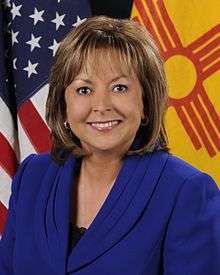
Susana Martinez, is the 31st and current Governor of New Mexico and current chairman of the Republican Governors Association.[3][4] She is the first Hispanic woman to be elected governor.[5]
- ^ Alberto Gonzales, Attorney General, by Lisa Tucker McElroy, 2006, Millbrook Press
- ^ "Brian Sandoval Becomes Nevada's 29th Governor". Renotahoe.about.com. January 2, 2011. Retrieved November 4, 2013.
- ^ Davis, Susan. Political Trivia: New Mexico Marks a Milestone,Wall Street Journal, June 2, 2010.
- ^ RGA announces 2016 Leadership
- ^ [1],Fox News Latino, November 20, 2015.
Rosa Rios (born July 17, 1965) is the 43rd and current Treasurer of the United States. A graduate of Harvard University, she was recently selected by the university as the first Latina in its 380-year history to have a portrait commissioned in her honor. She is the first Treasurer to have her current portfolio including oversight of the Bureau of Engraving and Printing, the United States Mint, Fort Knox, and Chair of the Advanced Counterfeiting Deterrence Steering Committee.
Business
-

Arte Moreno is the billionaire owner of the Anaheim Angels
-

Jordi Muñoz is the co-founder of 3D Robotics
Military
-

Marcelino Serna an undocumented Mexican immigrant who became the most decorated soldier from Texas in World War I. Serna was the first Hispanic to be awarded the Distinguished Service Cross.
-

Guy Gabaldon a United States Marine who, at age 18, captured or persuaded to surrender Japanese soldiers and civilians during the battles for Saipan and Tinian islands in 1944 during World War II.
-

Marcario Garcia was the first Mexican immigrant to receive the Medal of Honor, the United States' highest military decoration. He received the award for his heroic actions as a soldier during World War II.
-

Major Oscar F. Perdomo a recipient of the Distinguished Service Cross, was a United States Air Force officer who was the last "ace in a day" for the United States in World War II.
-

Everett Alvarez, Jr. is a former U.S. Navy Commander who endured one of the longest periods as a prisoner of war (POW) in American military history. Alvarez was the first U.S. pilot to be downed and detained during the Vietnam War and spent over eight years in captivity.
-

Robert Cardenas is a retired brigadier general of the United States Air Force. He served in World War II and the Vietnam War
-

Richard E. Cavazos became the U.S. Army's first Hispanic Four Star General
-
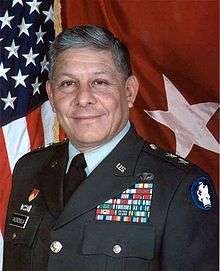
Alfred Valenzuela is a retired United States Army major general who commanded United States Army South (USARSO) at Fort Buchanan, Puerto Rico.
-

Ronald J. Rábago, the first Hispanic to be promoted to Rear Admiral (lower half) in the United States Coast Guard
Science and Technology
-
Jacob Bekenstein was a theoretical physicist who made fundamental contributions to the foundation of black hole thermodynamics and to other aspects of the connections between information and gravitation.
-

France Cordova is an astrophysicist, researcher and university administrator. As of March 2014, she is the director of the National Science Foundation.[1] Previously, she was the eleventh President of Purdue University.[2]
-
.jpg)
Alfredo Quinones-Hinojosa is a physician, author, and researcher. He is Director of the Brain Tumor Surgery Program at Johns Hopkins Bayview Medical Center, and the Director of the Brain Tumor Stem Cell Laboratory at Johns Hopkins School of Medicine.
-

Nora Volkow is the current director of the National Institute on Drug Abuse (NIDA),[3] which is part of the National Institutes of Health (NIH).[4]
-

Jose Hernandez an engineer and a former NASA astronaut, assigned to the crew of Space Shuttle mission STS-128. He developed equipment for full-field digital mammography at Lawrence Livermore National Laboratory.
-

Ellen Ochoa became the first Hispanic woman in the world to go into space. She is the current director of the Johnson Space Center.
-

Sidney M. Gutierrez former NASA Astronaut.
- ^ Morello, Lauren (March 12, 2014). "US Senate approves France Córdova to lead NSF". Nature. Retrieved March 18, 2014.
- ^ Medaris, Kim (July 9, 2007). "Córdova to hold ice cream social July 16 on first day as Purdue president". Purdue News Service. Retrieved 2008-11-22.
- ^ "Director's Page". National Institute on Drug Abuse. Retrieved 13 March 2015.
- ^ "Institutes, Centers & Offices". National Institutes of Health. Retrieved 13 March 2015.
Sport
-
.cropped.jpeg)
Ted Williams, baseball hall of famer, seventeen time All-Star and regarded as one of the greatest hitters in baseball history.[1]
-
.jpg)
Jim Plunkett, Heisman Trophy winner and two time Super Bowl winning quarterback.
-
.jpg)
Joe Kapp, is a member of the Canadian Football Hall of Fame, the B.C. Sports Hall of Fame, the BC Lions Wall of Fame, the College Football Hall of Fame. He is the only player to quarterback in the Super Bowl, Rose Bowl, and the Grey Cup.
-

Anthony Muñoz, a Pro Football Hall of Fame offensive tackle who played 13 seasons in the NFL earning eleven Pro Bowls. Muñoz is considered "one of the greatest offensive linemen in the history of the National Football League."[2]
-

Lee Trevino, professional golfer regarded as one of the greatest players in professional golf history,[3][4][5] and the greatest Hispanic golfer of all time.[6] He was inducted to the World Golf Hall of Fame in 1981.
-

Dallas Cowboys quarterback Tony Romo is the third ranked NFL career passing leader
- ^ "Ted Williams, Mexican American Baseball Superstar, War Hero". Fox News Latino. December 9, 2013. Retrieved December 6, 2015.
- ^ Anthony Munoz American athlete
- ^ "20 Greatest Golfers of All Time (Updated)". Athlon Sports. June 11, 2013. Retrieved January 1, 2015.
- ^ "Ranking Golf's Greatest Players Ever". Golf.about.com. August 29, 2014. Retrieved January 1, 2015.
- ^ "Ranking the 25 Best American Golfers of All Time". Bleacher Report. October 9, 2012. Retrieved January 1, 2015.
- ^ "5 Great Hispanic Golfers". Bleacher Report. September 15, 2010. Retrieved January 1, 2015.
See also
- American Mexican
- List of Mexican Americans
- Mexico–United States relations
- Hyphenated American
- Mexicans abroad
- Mexican cuisine
- Mexican people
- Tex-Mex cuisine
Ethnic:
- Melting pot ( metaphor for cultural fusion)
- Amerindian
- White Hispanic
- Olive skin
- Mestizo
- Bronze race
- Cosmic race
- Brown race
- Mestizos in the United States
Political:
Cultural:
- Chicanismo
- Chicano poetry
- List of Mexican American writers
- El Pueblo de Los Ángeles Historical Monument
References
- 1 2 3 US Census Bureau 2015 American Community Survey B03001 1-Year Estimates HISPANIC OR LATINO ORIGIN BY SPECIFIC ORIGIN retrieved September 22, 2016.
- ↑ "National Household Survey (NHS) Profile, 2011". 2.statcan.gc.ca. Retrieved 2014-03-24.
- ↑ "Table 4. Top Five States for Detailed Hispanic or Latino Origin Groups With a Population Size of One Million or More in the United States: 2010" (PDF). The Hispanic Population 2010. US Census Bureau. Retrieved 22 May 2012.
- ↑ Department of Homeland Security: "2012 Yearbook of Immigration Statistics" 2012
- ↑ U.S. State Department: "Annual Report of Immigrant Visa Applicants in the Family-sponsored and Employment-based preferences Registered at the National Visa Center as of November 1, 2015
- ↑ Population Reference Bureau (2013-11-13). "Latinos and the Changing Face of America – Population Reference Bureau". Prb.org. Retrieved 2014-01-06.
- ↑ Mexican Americans – MSN Encarta. Archived from the original on November 1, 2009.
- ↑ "The U.S.-Mexican War: War (1846-1848): The Borderlands on the Eve of War". PBS. 2006-03-14. Retrieved 2014-01-06.
- ↑ "American Experience | Remember the Alamo | Timeline". PBS. 2004-01-30. Retrieved 2014-01-06.
- ↑ "(DV) Felux: Remember the Alamo?". Dissidentvoice.org. Retrieved 2014-01-06.
- ↑ Las Tejanas: 300 Years of History - Teresa Palomo Acosta, Ruthe Winegarten - Google Boeken. Books.google.com. Retrieved 2014-01-06.
- ↑ Archived October 9, 2007, at the Wayback Machine.
- ↑ "The Hispanic Experience – Tejanos in the Texas Revolution". Houstonculture.org. Retrieved 2014-01-06.
- 1 2 3 Pitti, Jose (1988). A History of Mexican Americans in California. State of California, Department of Parks and Recreation. p.207.
- ↑ "American Experience | The Gold Rush | People & Events". PBS. 2006-09-13. Retrieved 2014-01-06.
- 1 2 "World Book Encyclopedia". Worldbook.com. Retrieved 2014-01-06.
- ↑ Martín Valadez, "Migration: To the United States," in Encyclopedia of Mexico, vol. 2, p. 890. Chicago: Fitzroy Dearborn, 1997.
- ↑ "Census Bureau Home Page". Census.gov. Retrieved 2014-01-06.
- ↑ "Changing Faiths: Latinos and the Transformation of American Religion (2006 Hispanic Religion Survey) | Pew Hispanic Center". Pewhispanic.org. Retrieved 2014-01-06.
- ↑ "U.S. Religious Landscape Survey: Religious Affiliation, Diverse and Dynamic, February 2008 | Pew Forum on Religion & Public Life" (PDF). Pewforum.org. Retrieved 2014-10-16.
- 1 2 3 "The Hispanic Population: 2010 Census Brief" (PDF). Retrieved November 16, 2012.
- 1 2 3 4 J.K. Estrada, A. Hidalgo-Miranda, I. Silva-Zolezzi and G. Jimenez-Sanchez. "Evaluation of Ancestry and Linkage Disequilibrium Sharing in Admixed Population in Mexico". ASHG. Retrieved July 18, 2012.
- ↑ Analysis of genomic diversity in Mexican Mestizo populations to develop genomic medicine in Mexico Silva-Zolezzi I, Hidalgo-Miranda A, Estrada-Gil J, Fernandez-Lopez JC, Uribe-Figueroa L, Contreras A, Balam-Ortiz E, del Bosque-Plata L, Velazquez Fernandez D, Lara C, Goya R, Hernandez-Lemus E, Davila C, Barrientos E, March S, Jimenez-Sanchez G. | National Institute of Genomic Medicine| May 26, 2009 "In this model, their mean ancestries (±Standard Deviation) were 0.552 ±0.154 for AMI, 0.418 ±0.155 for EUR, 0.018 ±0.035 for AFR, and 0.012 ±0.018 for EA"
- ↑ "Admixture and population structure in Mexican-Mestizos based on paternal lineages -". Journal of Human Genetics. Retrieved 2012-01-06.
In the total population sample, paternal ancestry was predominately European (64.9%), followed by Native American (30.8%) and African (4.2%).
- ↑ "Maternal admixture and population structure in Mexican-Mestizos based on mtDNA haplogroups". American Journal of Physical Anthropology. Retrieved 2014-07-26.
The predominant maternal ancestry was Native American (92.9%), including Haplogroups A, B, C, and D (47, 23.7, 15.9, and 6.2%, respectively). Conversely, European and African ancestries were less frequent (5.3% and 1.9%, respectively)
- ↑ "Large scale mitochondrial sequencing in Mexican Americans suggests a reappraisal of Native American origins". The vast majority of Mexican Americans, like Mexicans, carry a mixture of European and Indigenous American haplogroups. "For mtDNA variation, some studies have measured Native American, European and other contributions to Mexican and Mexican American populations, revealing 85 to 90% of mtDNA lineages are of Native American origin, with the remainder having European (5-7%) or other ancestry (3-5%). The difference is indicative of directional mating involving preferentially immigrant men and Native American women. This type of genetic asymmetry has been observed in other populations, including Brazilian individuals of African ancestry, as the analysis of sex specific and autosomal markers has revealed evidence for substantial European admixture that was mediated mostly through men. In our 384 completely sequenced Mexican American mitochondrial genomes, 12 (3.1%) are of other ancestry belonging to haplogroups L0a1a’3’, L2a1, L3b, L3d and U6a7; 52 (13.6%) belong to European haplogroups HV, JT, U1, U4, U5; and K and the majority (320, 83.3%) are of Native American ancestry."
- 1 2 en el censo de 1930 el gobierno mexicano dejó de clasificar a la población del país en tres categorías raciales, blanco, mestizo e indígena, y adoptó una nueva clasificación étnica que distinguía a los hablantes de lenguas indígenas del resto de la población, es decir de los hablantes de español.
- ↑ "Encyclopedia Britannica: Mexico Ethnic groups".
- ↑ Large differences in the variation of individual admixture estimates were seen across populations, with the variance in Native American ancestry between individuals ranging from 0.005 in Quetalmahue to 0.07 in Mexico City.
- ↑ "[Gene geography of Chile: regional distribution of American, European and African genetic contributions].". Rev Med Chil. 142 (3): 281–9. Mar 2014. doi:10.4067/S0034-98872014000300001. PMID 25052264.
- ↑ "Gene admixture in the Costa Rican population.". Ann. Hum. Genet. 67 (Pt 1): 71–80. 2013-03-25. doi:10.1046/j.1469-1809.2003.00010.x. PMID 12556237.
- ↑ "Geographic Patterns of Genome Admixture in Latin American Mestizos". Plos genetics. 2008-03-21. doi:10.1371/journal.pgen.1000037. Retrieved 2013-09-09.
- ↑ "Genetic admixture in three Mexican Mestizo populations based on D1S80 and HLA-DQA1 loci.". Am J Hum Biol. 14 (2): 257–63. doi:10.1002/ajhb.10020. PMID 11891937.
- ↑ In the total population sample, paternal ancestry was predominately European (64.9%), followed by Native American (30.8%) and African (4.2%). However, the European ancestry was prevalent in the north and west (66.7–95%) and, conversely, Native American ancestry increased in the center and southeast (37–50%), whereas the African ancestry was low and relatively homogeneous (0–8.8%), Journal of Human Genetics.
- ↑ Genetic structure of the populations migrating from San Luis Potosi and Zacatecas to Nuevo León in Mexico.
- ↑ Knight, Alan. 1990. "Racism, Revolution and indigenismo: Mexico 1910–1940". Chapter 4 in The Idea of Race in Latin America, 1870–1940. Richard Graham (ed.) pp. 78–85)
- 1 2 3 4 5 Gibson, Campbell; Jung, Kay (September 2002). "Historical Census Statistics on Population Totals By Race, 1790 to 1990, and By Hispanic Origin, 1970 to 1990, For The United States, Regions, Divisions, and States". Working Paper Series No. 56. Retrieved December 7, 2006.
- ↑ "US Population in the 1930 Census by Race". 2002. Retrieved December 7, 2006.
- ↑ "Surveillance Epidemology and End Results. Race and Nationality Descriptions from the 2000 US Census and Bureau of Vital Statistics. 2007. May 21, 2007." (PDF). Retrieved 2014-01-06.
- ↑ , Clare Sheridan, 2003.
- 1 2 3 "Mexican American Voters / Voting Rights and Citizenship". cuny.edu.
- ↑ De Genova, Nicholas (2006). Racial Transformations: Latinos And Asians. Duke University Press. p. 96. ISBN 978-0-8223-3716-4.
- 1 2 Haney-Lopez, Ian F. (1996). "3 Prerequisite cases". White by Law: The Legal Construction of Race. New York University. p. 61.
- 1 2 Haney-Lopez, Ian F. (1996). "Appendix "A"". White by Law: The Legal Construction of Race. New York University.
- 1 2 3 4 "RACE – History – Post-War Economic Boom and Racial Discrimination". Understandingrace.org. 1956-12-21. Retrieved 2014-01-06.
- 1 2 JS Online: Filmmaker explores practice of redlining in documentary Archived September 29, 2007, at the Wayback Machine.
- 1 2 Pulido, Laura. Black, Brown, Yellow, and Left: Radical Activism in Los Angeles. University of California Press. p. 53. ISBN 978-0-520-24520-4.
- ↑ Foley, Neil (1998). The White Scourge: Mexicans, Blacks, and Poor Whites in Texas Cotton Culture. University of California Press.
- 1 2 Jason McDonald (14 June 2012). Racial Dynamics in Early Twentieth-Century Austin, Texas. Lexington Books. ISBN 978-0739170977.
- ↑ Scruggs, O. (1984). Operation Wetback: The Mass Deportation of Mexican Undocumented Workers in 1954. Labor History, 25(1), 135–137. Retrieved from America: History & Life database.
- ↑ Publications (2007-06-07). "Summary of Findings: Mixed Views on Immigration Bill". People-press.org. Retrieved 2014-01-06.
- ↑ "FRB: Testimony, Greenspan-Aging population-February 27, 2003". Federalreserve.gov. 2003-02-27. Retrieved 2014-01-06.
- ↑ "Immigration curbs hurting US, Greenspan says". USA Today. May 17, 2007. Retrieved May 12, 2010.
- ↑ "Mexican Bank of Mexico". Retrieved 18 November 2016.
- ↑ Flores Niemann Yolanda, et al. ‘’Black-Brown Relations and Stereotypes’’ (2003); Charles Ramírez Berg, ’’Latino Images in Film: Stereotypes, Subversion, & Resistance’’ (2002); Chad Richardson, ‘’Batos, Bolillos, Pochos, and Pelados: Class & Culture on the South Texas Border’’ (1999)
- ↑ Life on the Texas-Mexico Border: Myth and reality as represented in Mainstream and Independent Western Cinema Archived October 22, 2007, at the Wayback Machine.
- ↑ "Steven H. Wilson | Brown over "Other White": Mexican Americans' Legal Arguments and Litigation Strategy in School Desegregation Lawsuits | Law and History Review, 21.1". The History Cooperative. Retrieved 2014-01-06.
- ↑ 1930s Mexican Deportation: Educator brings attention to historic period and its effect on her family Archived October 5, 2006, at the Wayback Machine.
- 1 2 Counseling Kevin: The Economy Archived September 2, 2007, at the Wayback Machine.
- ↑ Ressner, Jeffrey (May 29, 2006). "How Immigration is Rousing the Zealots". Time. Retrieved May 12, 2010.
- ↑ Hate Crime Statistics 2012
- ↑ "FBI Statistics Show Anti-Latino Hate Crimes on the Rise". Democracy Now!. Retrieved 2014-01-06.
- ↑ http://ccsre.stanford.edu/reports/exec_summary5.pdf
- ↑ Fronteras: "Report Shows Anti-Latino Hate Crimes Down 31 Percent" by Erin Siegal December 17, 2012
- ↑ Cowen, Tyler (June 18, 2006). "Assimilation of immigrants is not a problem in the U.S". Deseret News (Salt Lake City).
- ↑ "Mexican American Proarchive". Mexican American Proarchive.
- ↑ LeeAnne, Gelletly. Mexican Immigration. Philadelphia: Mason Crest.
- ↑ South, Scott J.; Crowder, Kyle; and Chavez, Erick. "Geographic Mobility and Spatial Assimilation among US Latino Immigrants." International Migration Review 2005 39(3): 577–607. ISSN 0197-9183
- 1 2 3 4 Mexican Immigration to the United States edited by George J. Borjas page 246 | retrieved March 20, 2013
- ↑ Mexican Immigration to the United States edited by George J. Borjas page 252 | retrieved March 20, 2013
- 1 2 3 James, Franklin J., and Eileen A. Tynan. Minorities in the Sunbelt. New Jersey: The State University of New Jersey, 1984.
- 1 2 Martin, Michael E. Residential Segregation Patterns of Latinos in the United States, 1991–2000. New York: Routledge, 2007.
- 1 2 3 Ferg-Cadima, James A. Black, "White and Brown". Mexican American Legal Defense and Educational Fund. April 28, 2008 Archived October 8, 2007, at the Wayback Machine.
- 1 2 3 White, Michael J.; Bueker, Catherine; Glick, Jennifer E. "The Impact of Immigration on Residential Segregation Revisited" (PDF). Brown.edu.
- ↑ Richards, Valencia; Black, Mary (2002). "'Mexican Americans Don't Value Education!'--On the Basis of the Myth, Mythmaking, and Debunking". Journal of Latinos & Education. 1: 81. doi:10.1207/S1532771XJLE0102_2.
- ↑ Kiyama, J (2011). "Family lessons and funds of knowledge: College-going paths in mexican american families". Journal of Latinos and Education. 10: 23–42. doi:10.1080/15348431.2011.531656.
- ↑ Espino, M (2016). "The value of education and educación: Nurturing mexican american children's educational aspirations to the doctorate". Journal of Latinos and Education. 15: 73–90. doi:10.1080/15348431.2015.1066250.
- ↑ Altschul, I (2011). "Parental involvement and the academic achievement of mexican american youths: What kinds of involvement in youths' education matter most?". Social Work Research. 35: 159. doi:10.1093/swr/35.3.159.
- ↑ Keith, P; Lichtman, M (1995). "Does parental involvement influence the academic achievement of mexican-american eighth graders? results from the national education longitudinal study". School Psychology Quarterly. 9: 256–272. doi:10.1037/h0088292.
- ↑ Carranza, F; You, S; Chhuon, V; Hudley, C (2009). "Mexican american adolescents' academic achievement and aspirations: The role of perceived parental educational involvement, acculturation, and self-esteem". Adolescence. 44 (174): 313.
- ↑ American Fact Finder US Census Bureau. US Census Bureau http://factfinder.census.gov/faces/tableservices/jsf/pages/productview.xhtml?src=CF. Retrieved 2015-11-24. Missing or empty
|title=(help) - 1 2 3 4 5 Data Access and Dissemination Systems (DADS). "American FactFinder - Results". census.gov.
- ↑ Data Access and Dissemination Systems (DADS). "American FactFinder - Results". census.gov.
- ↑ "American FactFinder". Factfinder.census.gov. Retrieved 2014-01-06.
- 1 2 US Census Bureau: Table QT-P10 Hispanic or Latino by Type: 2010 retrieved January 22, 2012 - select state from drop-down menu
- ↑ http://dola.colorado.gov/dlg/demog/2010data/race%20and%20hispanic%20origin%20muni.pdf
- ↑ http://scseed.org/wb/media/SLV%20Statistical%20Profile%2012-03-07.pdf
Bibliography/further reading
- Gómez-Quiñones, Juan, and Irene Vásquez. Making Aztlán: Ideology and Culture of the Chicana and Chicano Movement, 1966-1977 (2014)
- Meier, Matt S., and Margo Gutiérrez. Encyclopedia of the Mexican American civil rights movement (Greenwood 2000) online
- Quiroz, Anthony (ed.), Leaders of the Mexican American Generation: Biographical Essays. Boulder, CO: University Press of Colorado, 2015.
- Orozco, Cynthia E. No Mexicans, women, or dogs allowed: The rise of the Mexican American civil rights movement (University of Texas Press, 2010) online
- Rosales, F. Arturo. Chicano! The history of the Mexican American civil rights movement (Arte Público Press, 1997); online
- Sánchez, George I. "Ideology, and Whiteness in the Making of the Mexican American Civil Rights Movement, 1930–1960" Journal of Southern History (2006) 72#3 pp. 569–604 in JSTOR
External links
| Wikimedia Commons has media related to Mexican Americans. |
| Look up Mexamerican in Wiktionary, the free dictionary. |
- California Ethnic and Multicultural Archives – In the Chicano/Latino Collections - University of California Santa Barbara
- California Ethnic and Multicultural Archives – Digital Chicano Art - University of California Santa Barbara
- Calisphere > California Cultures > Hispanic Americans - University of California System
- ImaginArte – Interpreting and Re-imaging Chican@Art - University of California Santa Barbara
- Manifest Destinies: The Making of the Mexican American Race (book)
- Mexican American News – Network of the Mexican American Community
- Mexican Americans MSN Encarta (Archived 2009-11-01)
- Think Mexican – News, Culture, and Information on the Mexican Community







